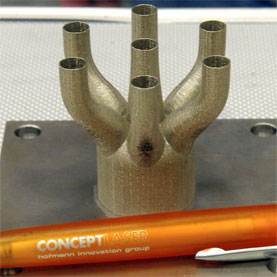NASA Uses 3D Printing to Build Rocket Engine
When NASA's Space Launch System (SLS) rockets beyond Earth orbit, a lot more may be riding on it than just a crew of astronauts: the SLS may be pivotal not only in the advancement of US spaceflight, but also in rescuing the US manufacturing industry.
 The SLS aims to expand the frontiers of scientific research and human exploration beyond Earth's orbit. Its maiden voyage, named Exploration Mission 1, will launch an unmanned spacecraft into orbit around the moon in preparation for Exploration Mission 2. The SLS's second mission, slated for 2021 will use a 130-metric-ton version of the SLS to carry a crew of four in the Orion Multipurpose Crew Vehicle.
The SLS aims to expand the frontiers of scientific research and human exploration beyond Earth's orbit. Its maiden voyage, named Exploration Mission 1, will launch an unmanned spacecraft into orbit around the moon in preparation for Exploration Mission 2. The SLS's second mission, slated for 2021 will use a 130-metric-ton version of the SLS to carry a crew of four in the Orion Multipurpose Crew Vehicle.
Lifting over 286,000 pounds, the SLS will be “the largest launch vehicle ever built” and will provide 20 percent more thrust than the Saturn V, according to NASA.
But this isn't necessarily the SLS' crowing quality.
In the interests of cost and quality control, NASA is relying on additive manufacturing to deploy the Space Launch System. At the Marshall Space Flight Center in Huntsville, Ala., scientists are testing a type of additive manufacturing called selective laser melting (SLM), which fuses together layers of powdered alloy with a laser beam.
The hope is that by using the M2 Cusing Machine (the SLM device), they can sidestep problems the weak link created by welding forged pieces together. And while creating a structure via powdered alloy yields a completed product falling in the “minimal acceptable range” for structural integrity, it may prove to be advantageous over traditional manufacturing methods due to its low cost and flexibility.
Despite its benefits, SLM won't be employed on every component of the J-2X or RS-25 engine parts. Many parts are too large to be created within the M2 Cusing's limited build chamber, whereas others operate under extreme conditions that require they be as strong as possible.
Depending on how successful the printed J-2X parts fare, NASA hopes to take advantage of SLM in constructing the RS-25. But even if NASA doesn't jump on board, additive manufacturing still will play a large role in aerospace engineering, as many of their contractors are using the technology in their own factories.
Full story at Scientific American










